Assessment of Radon and Naturally Occurring Radionuclides in the Vredefort Meteorite Crater in South Africa
Abstract
1. Introduction
2. The Vredefort Crater
3. Geological Setting
4. Radionuclide Measurements and Assessment
4.1. In Situ Survey of Naturally Occurring Radionuclides
4.2. Sample Measurements, Analyses, and Mapping
4.3. Indoor Radon Assessment
5. Results and Discussion
6. Conclusions
Author Contributions
Funding
Institutional Review Board Statement
Informed Consent Statement
Data Availability Statement
Acknowledgments
Conflicts of Interest
Correction Statement
References
- Zeeb, H.; Shannoun, F.; World Health Organization. WHO Handbook on Indoor Radon: A Public Health Perspective; World Health Organization: Geneva, Switzerland, 2009.
- Dubois, G. An Overview of Radon Surveys in Europe; European Commission: Luxembourg, 2005. [Google Scholar]
- Pantelić, G.; Čeliković, I.; Živanović, M.; Vukanac, I.; Nikolić, J.K.; Cinelli, G.; Gruber, V. Qualitative overview of indoor radon surveys in Europe. J. Environ. Radioact. 2019, 204, 163–174. [Google Scholar] [CrossRef] [PubMed]
- Műllerová, M.; Kozak, K.; Kovács, T.; Smetanová, I.; Csordás, A.; Grzadziel, D.; Holý, K.; Mazur, J.; Moravcsík, A.; Neznal, M.; et al. Indoor radon survey in Visegrad countries. Appl. Radiat. Isot. 2016, 110, 124–128. [Google Scholar] [CrossRef] [PubMed]
- Bezuidenhout, J. Estimating geothermal and background radiation hotspots from primordial radionuclide concentrations in geology of South Africa. J. Environ. Radioact. 2023, 259–260, 107118. [Google Scholar] [CrossRef]
- Smit, H.A.; Bezuidenhout, J. Geology and climate: A novel method to estimate indoor radon exposure risk in South Africa. S. Afr. Geogr. J. 2023, 31, 1–4. [Google Scholar] [CrossRef]
- Bezuidenhout, J. Estimating indoor radon concentrations based on the uranium content of geological units in South Africa. J. Environ. Radioact. 2021, 234, 106647. [Google Scholar] [CrossRef] [PubMed]
- Yuan, Y.; Morishima, H.; Shen, T.; Koga, T.; Wei, L.; Sugahara, T. Measurements of Rn-222, Rn-220 and their decay products in the environmental air of the high background radiation areas in Yangjiang, China. J. Radiat. Res. 2000, 41, 25–30. [Google Scholar] [CrossRef] [PubMed]
- Bisschoff, A.A. The history and origin of the Vredefort Dome. S. Afr. J. Sci. 1988, 84, 413. [Google Scholar]
- Reimold, W.U.; Gibson, R.L. Geology and evolution of the Vredefort impact structure, South Africa. J. Afr. Earth Sci. 1996, 23, 125–162. [Google Scholar] [CrossRef]
- Reimold, W.U. A review of the geology of and deformation related to the Vredefort Structure, South Africa. J. Geol. Educ. 1993, 41, 106–117. [Google Scholar] [CrossRef]
- Reimold, W.U.; Hauser, N.; Oliveira, A.L.; Maciel, A.R.; Goderis, S.; Pittarello, L.; Wegner, W.; Fischer-Goedde, M.; Koeberl, C.; Debaille, V. Genesis of the mafic impact melt rock in the northwest sector of the Vredefort Dome, South Africa. Meteorit. Planet. Sci. 2023, 58, 907–944. [Google Scholar] [CrossRef]
- Fagereng, Å.; Harris, C.; La Grange, M.; Stevens, G. Stable isotope study of the Archaean rocks of the Vredefort impact structure, central Kaapvaal Craton, South Africa. Contrib. Mineral. Petrol. 2008, 155, 63–78. [Google Scholar] [CrossRef]
- Ivanov, B.A. Numerical Modelling of the Largest Terrestrial Meteorite Craters. Sol. Syst. Res. 2005, 39, 381–409. [Google Scholar] [CrossRef]
- Schreyer, W. Metamorphism and fluid inclusions in the basement of the Vredefort dome, South Africa: Guidelines to the origin of the structure. J. Petrol. 1983, 24, 26–47. [Google Scholar] [CrossRef]
- Henkel, H.; Reimold, W.U. Integrated geophysical modelling of a giant, complex impact structure: Anatomy of the Vredefort Structure, South Africa. Tectonophysics 1998, 287, 1–20. [Google Scholar] [CrossRef]
- Hart, R.J.; Andreoli, M.A.G.; Tredoux, M.; De Wit, M.J. Geochemistry across an exposed section of Archaean crust at Vredefort, South Africa: With implications for mid-crustal discontinuities. Chem. Geol. 1990, 82, 21–50. [Google Scholar] [CrossRef]
- Engels, B.; Koch, P.; Badman, T. Serial Natural World Heritage Properties 2009-064; IUCN (International Union for Conservation of Nature): Gland, Switzerland, 2009. [Google Scholar]
- Meisenberg, O.; Gierl, S.; Tschiersch, J. Measurement of thoron and its progeny in traditional and modern earthen buildings in Germany-methodology and results. In Proceedings of the 2013 International Radon Symposium of the American Association of Radon Scientists and Technologists, Springfield, IL, USA, 22–25 September 2013; Available online: https://aarst.org/symposium-proceedings/ (accessed on 1 October 2023).
- Reimold, W.U.; Gibson, R.L. The melt rocks of the Vredefort impact structure–Vredefort Granophyre and pseudotachylitic breccias: Implications for impact cratering and the evolution of the Witwatersrand Basin. Geochemistry 2006, 66, 1–35. [Google Scholar] [CrossRef]
- Lana, C. Geology and geochemistry of a granite-greenstone association in the southeastern Vredefort dome, South Africa. S. Afr. J. Geol. 2003, 106, 291–314. [Google Scholar] [CrossRef]
- Reimold, W.U.; Gibson, R.L. Meteorite Impact! The Danger from Space and South Africa’s Mega-Impact the Vredefort Structure; Chris van Rensburg Publications (Pty) Ltd.: Melville, South Africa, 2005. [Google Scholar]
- Bisschoff, A.A. The dioritic rocks of the Vredefort Dome. Trans. Geol. Soc. S. Afr. 1972, 75, 31–45. [Google Scholar]
- Molezzi, M.G.; Hein, K.A.A.; Manzi, M.S.D. Mesoarchaean-Palaeoproterozoic crustal-scale tectonics of the central Witwatersrand basin-Interpretation from 2D seismic data and 3D geological modelling. Tectonophysics 2019, 761, 65–85. [Google Scholar] [CrossRef]
- Bezuidenhout, J. In situ gamma ray measurements of radionuclides at a disused phosphate mine on the West Coast of South Africa. J. Environ. Radioact. 2015, 150, 1–8. [Google Scholar] [CrossRef]
- Bezuidenhout, J. The Testing and Implementation of a Transportable and Robust Radio-element Mapping System. S. Afr. J. Sci. 2015, 111, 1–7. [Google Scholar] [CrossRef][Green Version]
- Bezuidenhout, J. Measuring naturally occurring uranium in soil and minerals by analysing the 352 keV gamma-ray peak of 214Pb using a NaI(Tl)-detector. J. Appl. Radiat. Isot. 2013, 80, 1–6. [Google Scholar] [CrossRef] [PubMed]
- Kotrappa, P.; Dempsey, J.C.; Ramsey, R.W.; Stieff, L.R. A practical E-PERM (electret passive environmental radon monitor) system for indoor 222Rn measurement. Health Phys. 1990, 58, 461–467. [Google Scholar] [CrossRef] [PubMed]
- Shahbazi-Gahrouei, D.; Setayandeh, S.; Gholami, M. A review on natural background radiation. Adv. Biomed. Res. 2013, 2, 65. [Google Scholar] [CrossRef]
- Mellor, E.T. The geology of the Witwatersrand: An Explanation of the Geological Map of the Witwatersrand Goldfield; Government Printing and Stationery Office: Pretoria, South Africa, 1917.
- Nel, L.T. The geology of the country around Vredefort. Spec. Publ. Geol. Surv. S. Afr. 1927, 6, 134. [Google Scholar]
- Holland, M.J.; Stanistreet, I.G.; McCarthy, T.S. Tectonic control on the deposition of the Turffontein Subgroup around the Vredefort Dome. S. Afr. J. Geol. 1990, 93, 158–168. [Google Scholar]
- World Health Organization. International Radon Project: Survey on Radon Guidelines, Programmes and Activities (No. WHO/HSE/RAD/07.01); WHO: Geneva, Switzerland, 2007.
- Jarque, C.M.; Bera, A.K. Efficient tests for normality, homoscedasticity and serial independence of regression residuals. Econ. Lett. 1980, 6, 255–259. [Google Scholar] [CrossRef]
- Miles, J.C.H. Mapping the proportion of the housing stock exceeding a radon reference level. Radiat. Prot. Dosim. 1994, 56, 207–210. [Google Scholar] [CrossRef]
- Nero, A.V.; Schwehr, M.B.; Nazaroff, W.W.; Revzan, K.L. Distribution of airborne radon-222 concentrations in US homes. Science 1986, 234, 992–997. [Google Scholar] [CrossRef]
- Daraktchieva, Z.; Miles, J.C.H.; McColl, N. Radon, the lognormal distribution and deviation from it. J. Radiol. Prot. 2014, 34, 183. [Google Scholar] [CrossRef]
- Cinelli, G.; Tondeur, F. Log-normality of indoor radon data in the Walloon region of Belgium. J. Environ. Radioact. 2015, 143, 100–109. [Google Scholar] [CrossRef] [PubMed]
- UNSCEAR. Sources and Effects of Ionizing Radiation, Annex B: Exposures from Natural Sources; United Nations Publications: New York, NY, USA, 2000. [Google Scholar]
- Le Roux, R.R.; Bezuidenhout, J.; Smit, H.A. The influence of different types of granite on indoor radon concentrations of dwellings in the South African West Coast Peninsula. J. Radiat. Res. Appl. Sci. 2019, 12, 375–382. [Google Scholar] [CrossRef]
- Le Roux, R.; Bezuidenhout, J.; Smit, H. Indoor radon measurements for the South African West coast peninsula. Radiat. Prot. Dosim. 2020, 191, 144–149. [Google Scholar] [CrossRef] [PubMed]
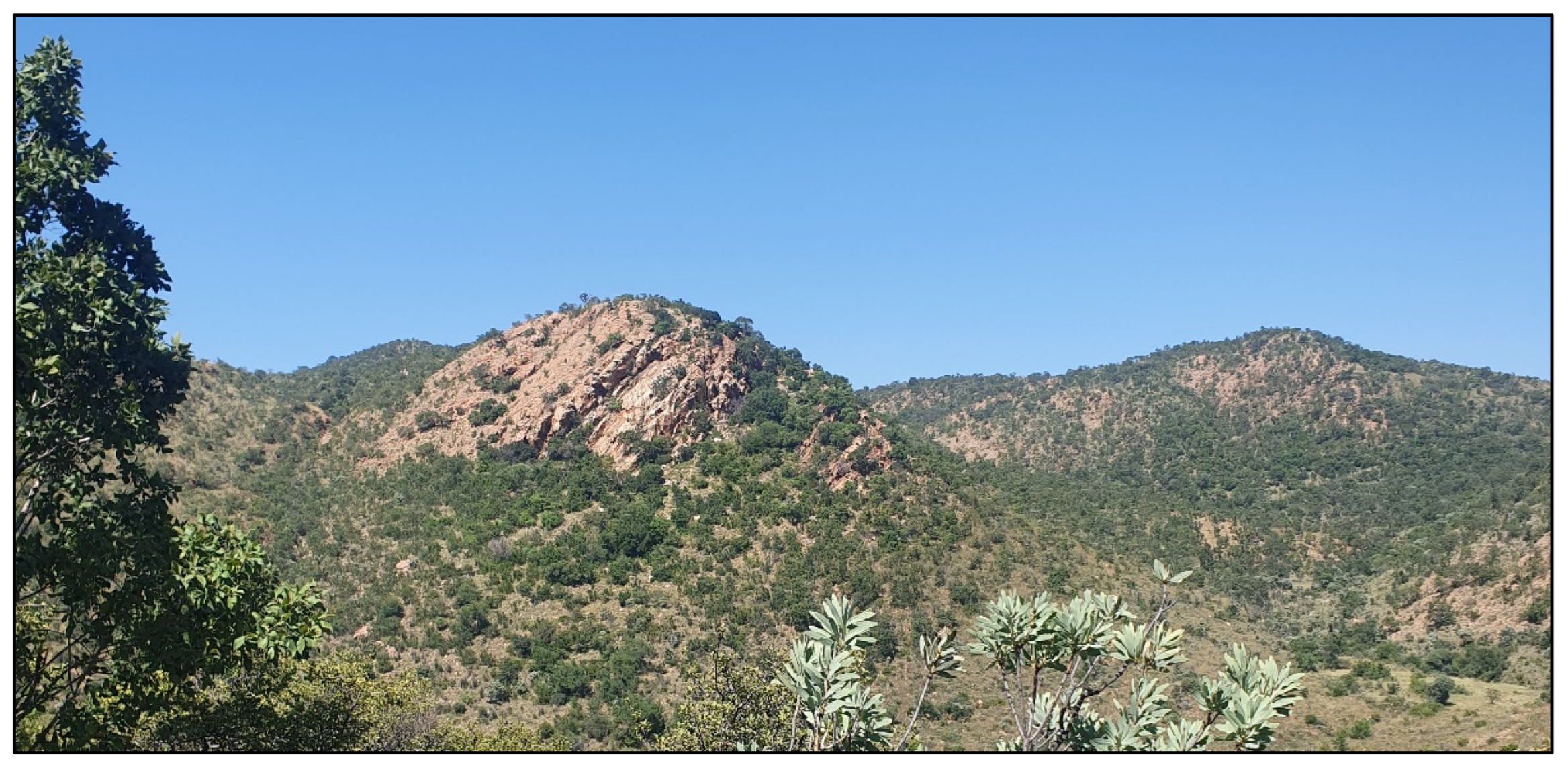
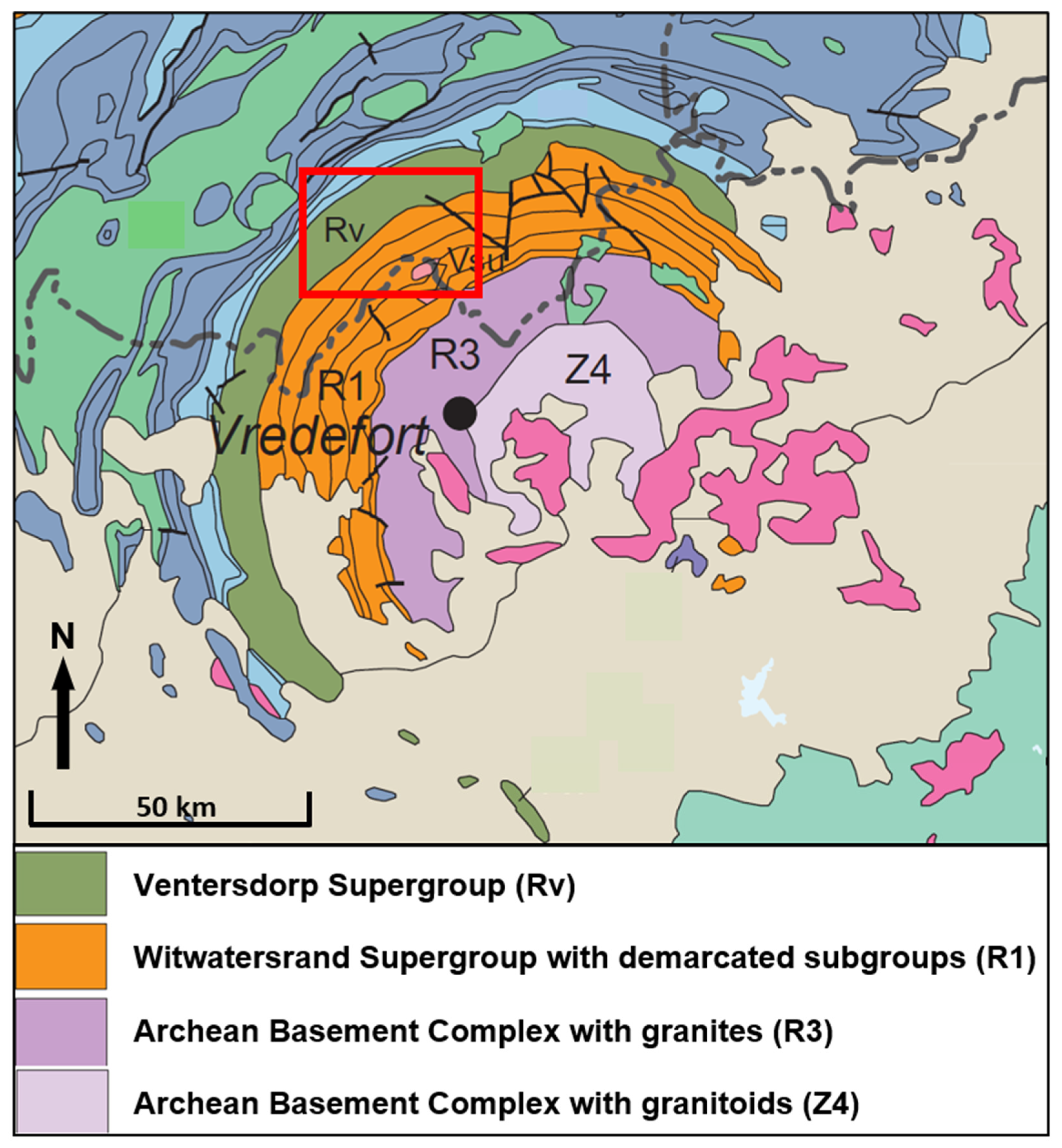
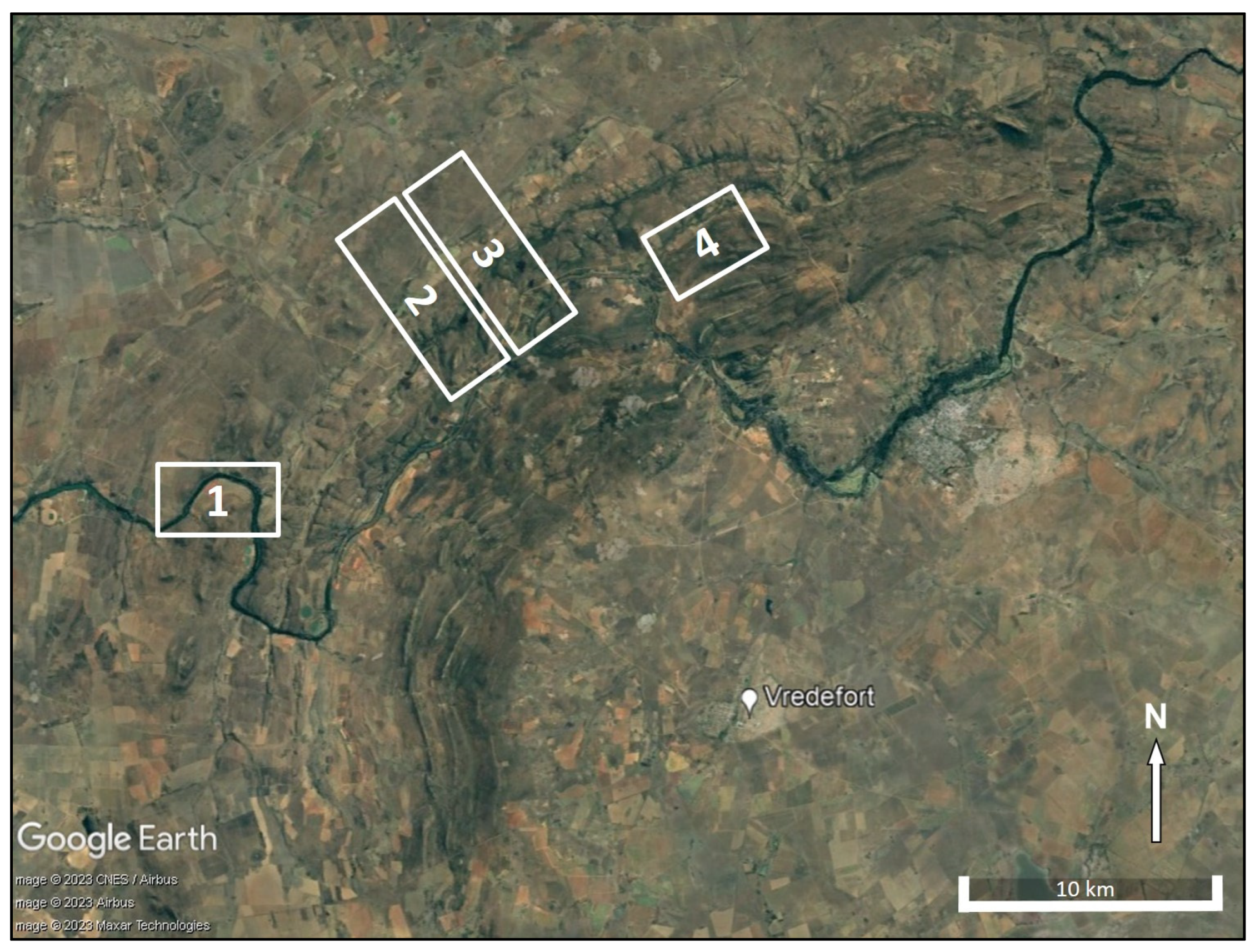
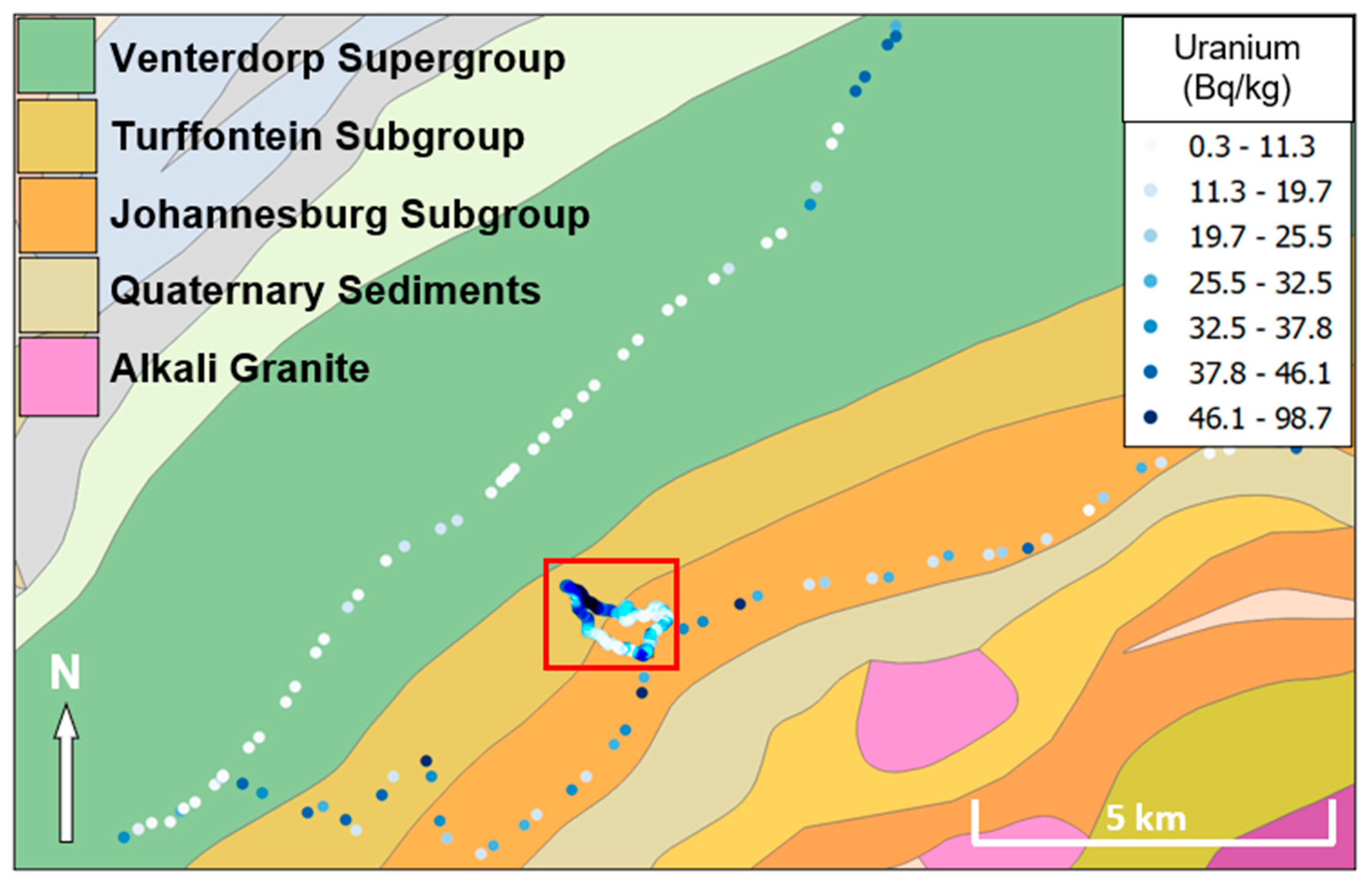
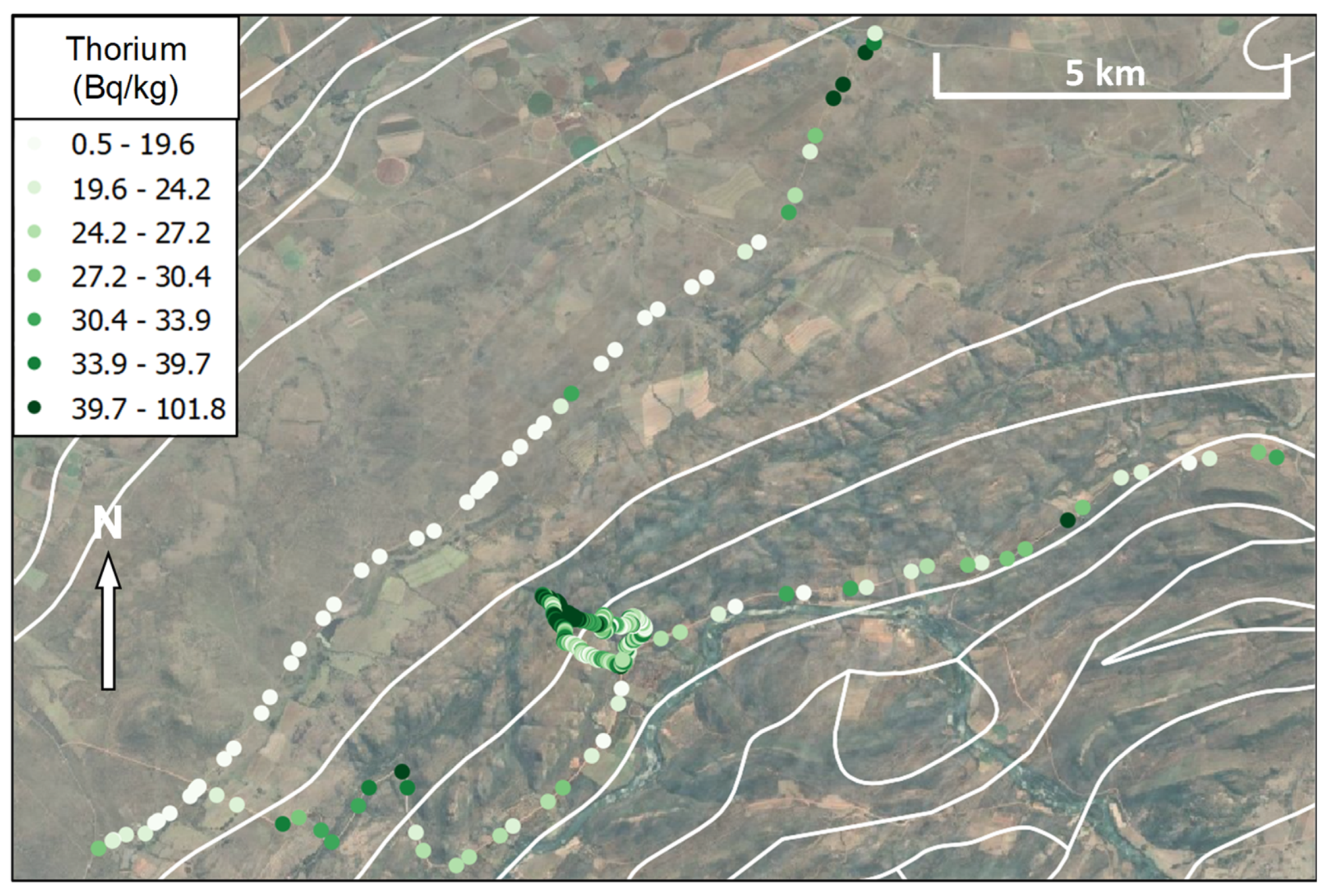
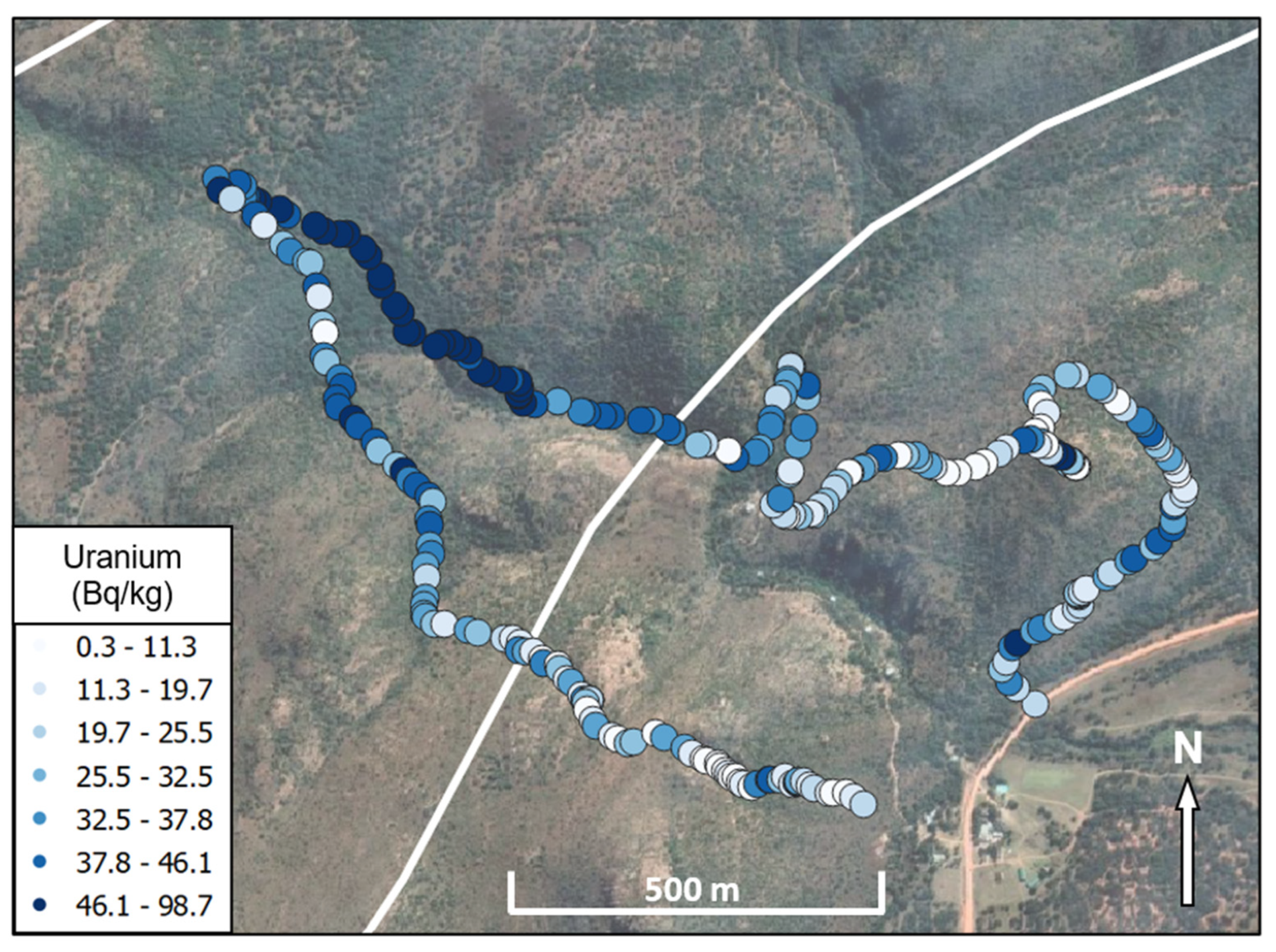
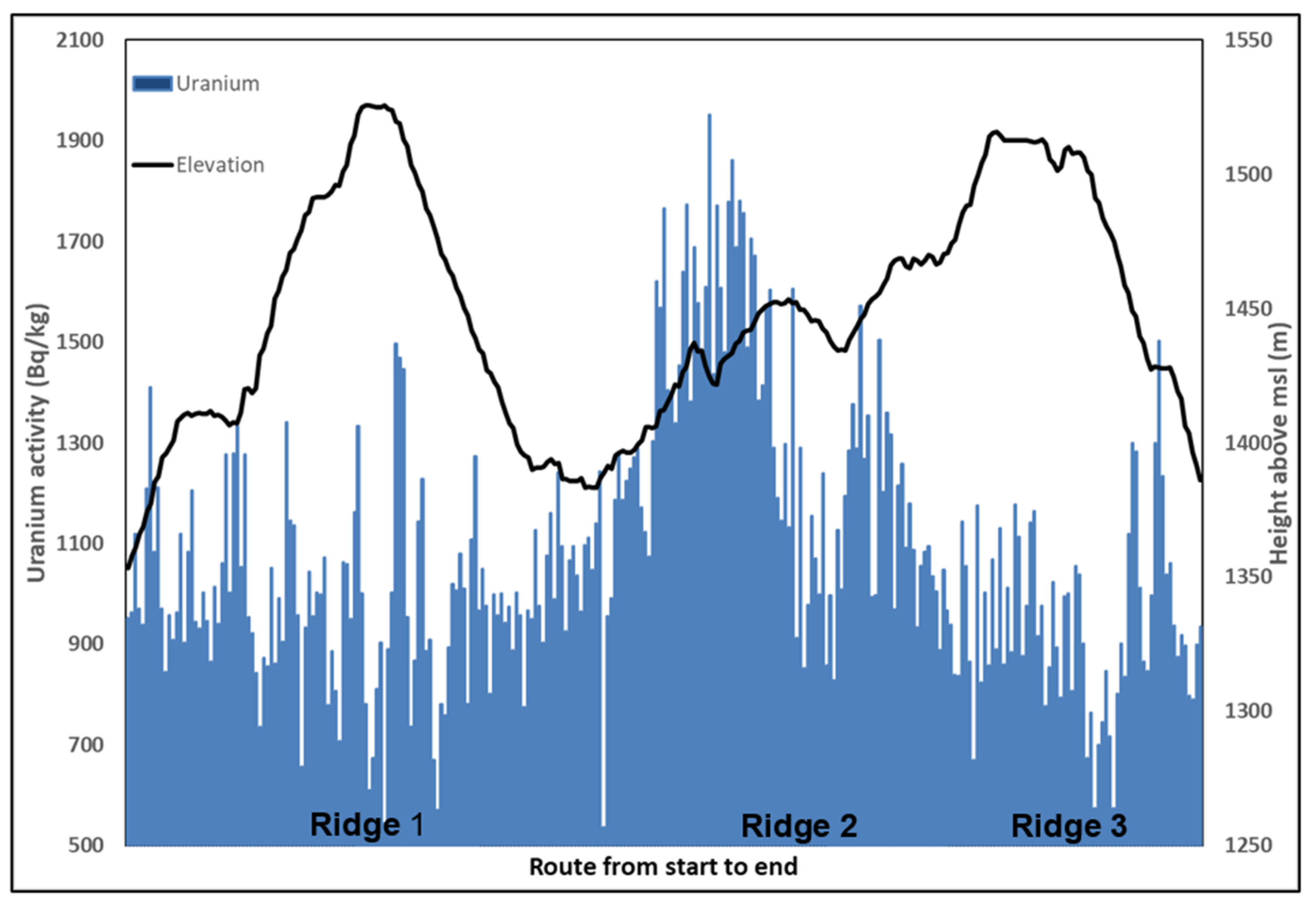
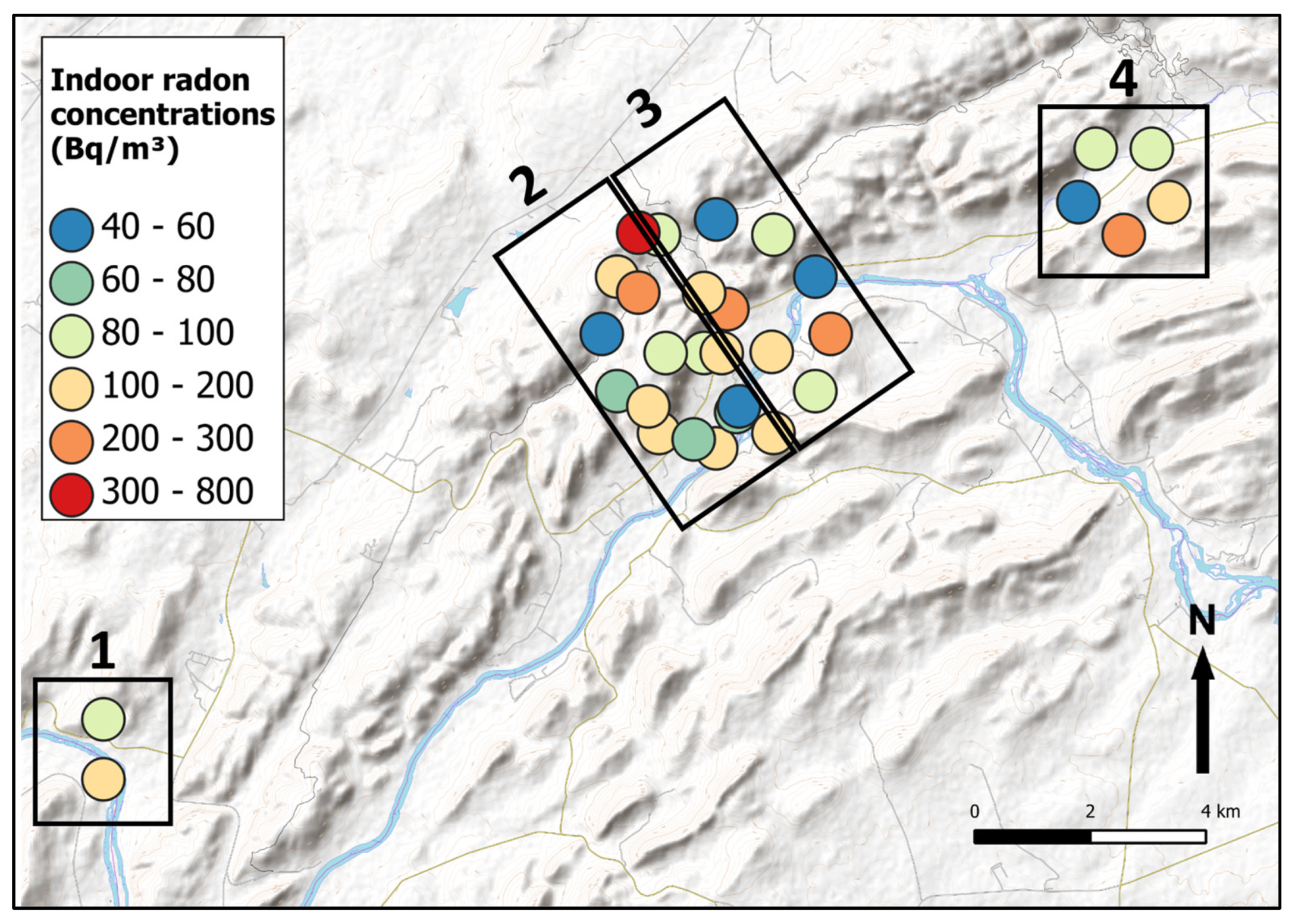
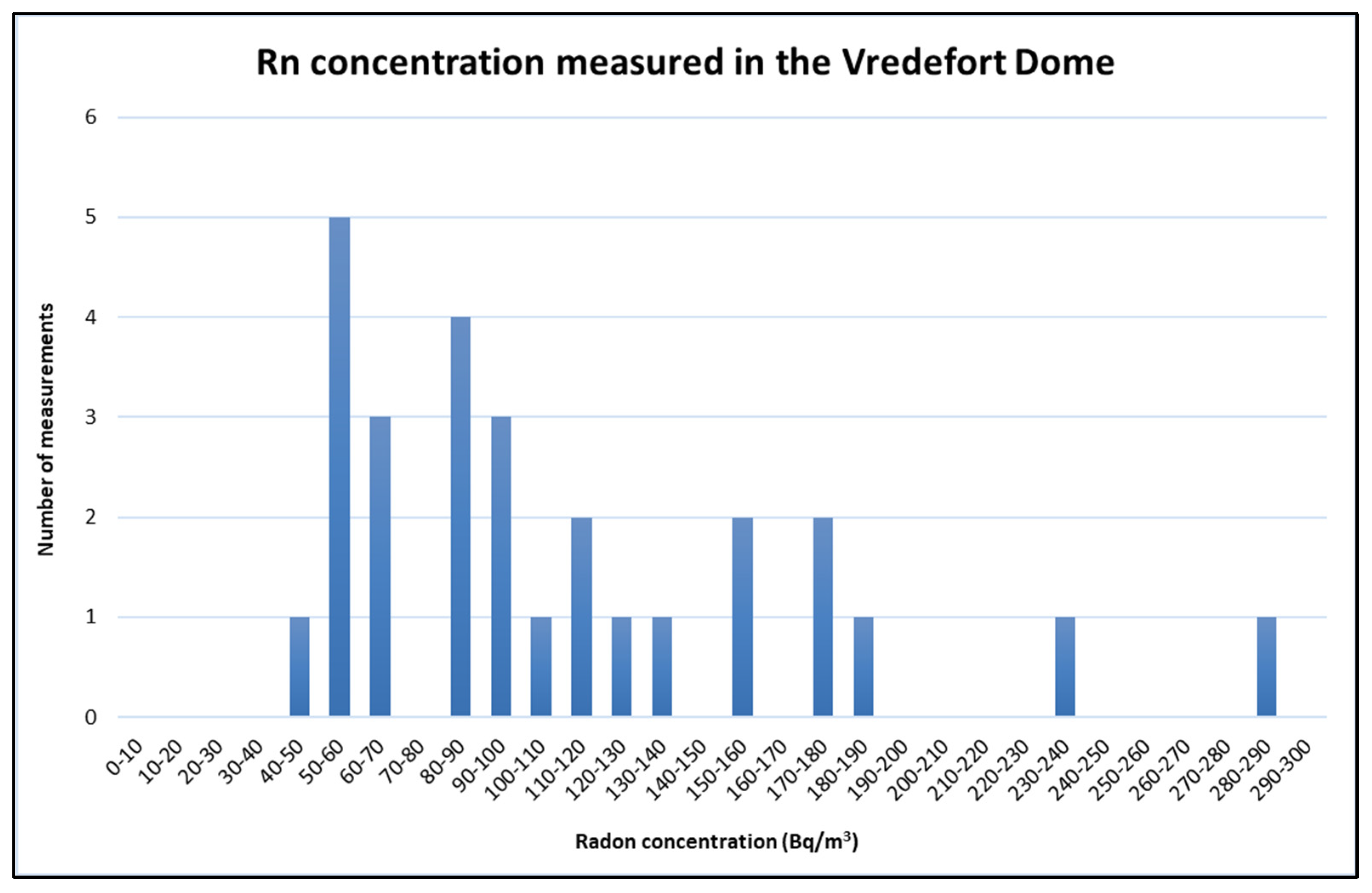
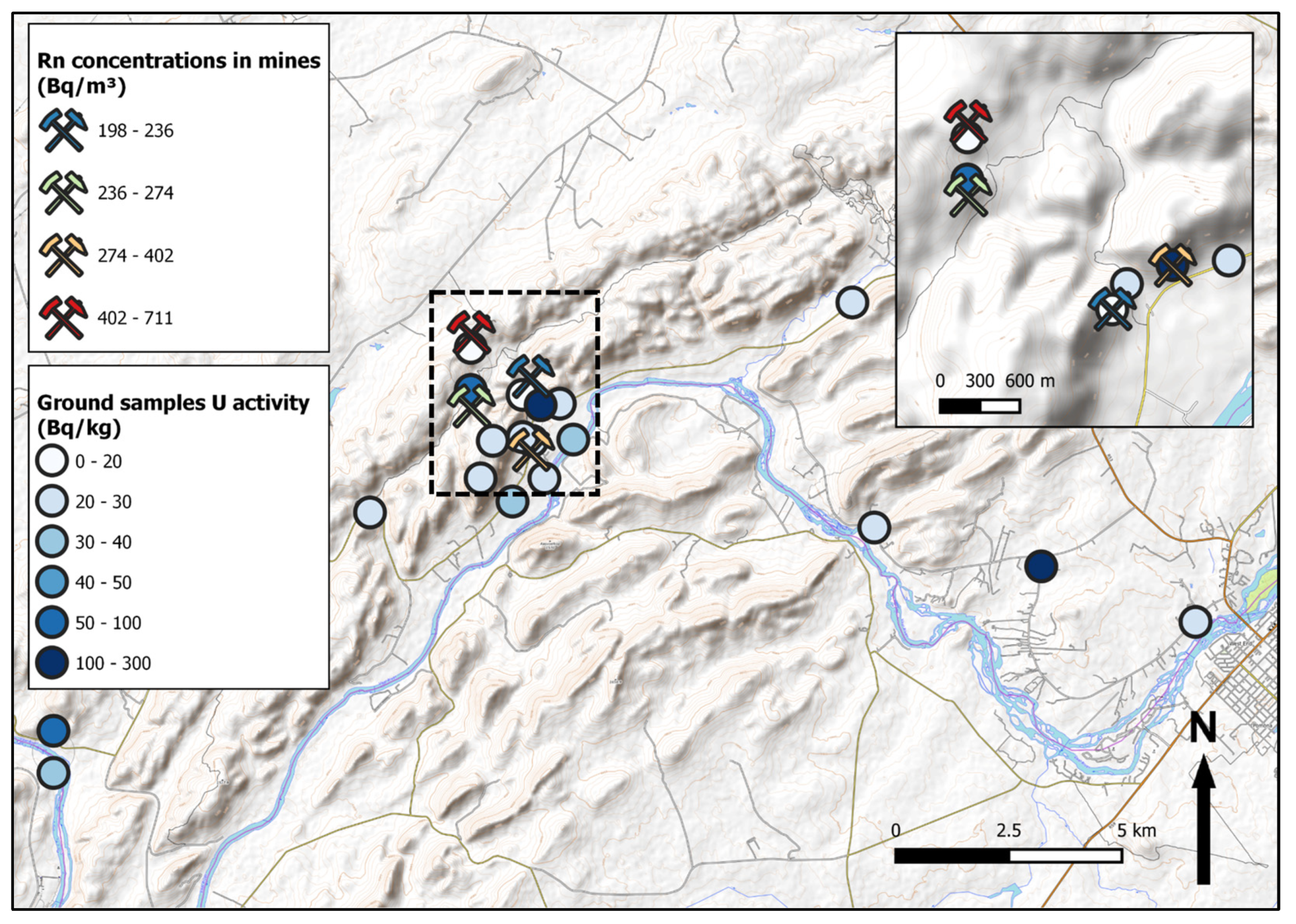
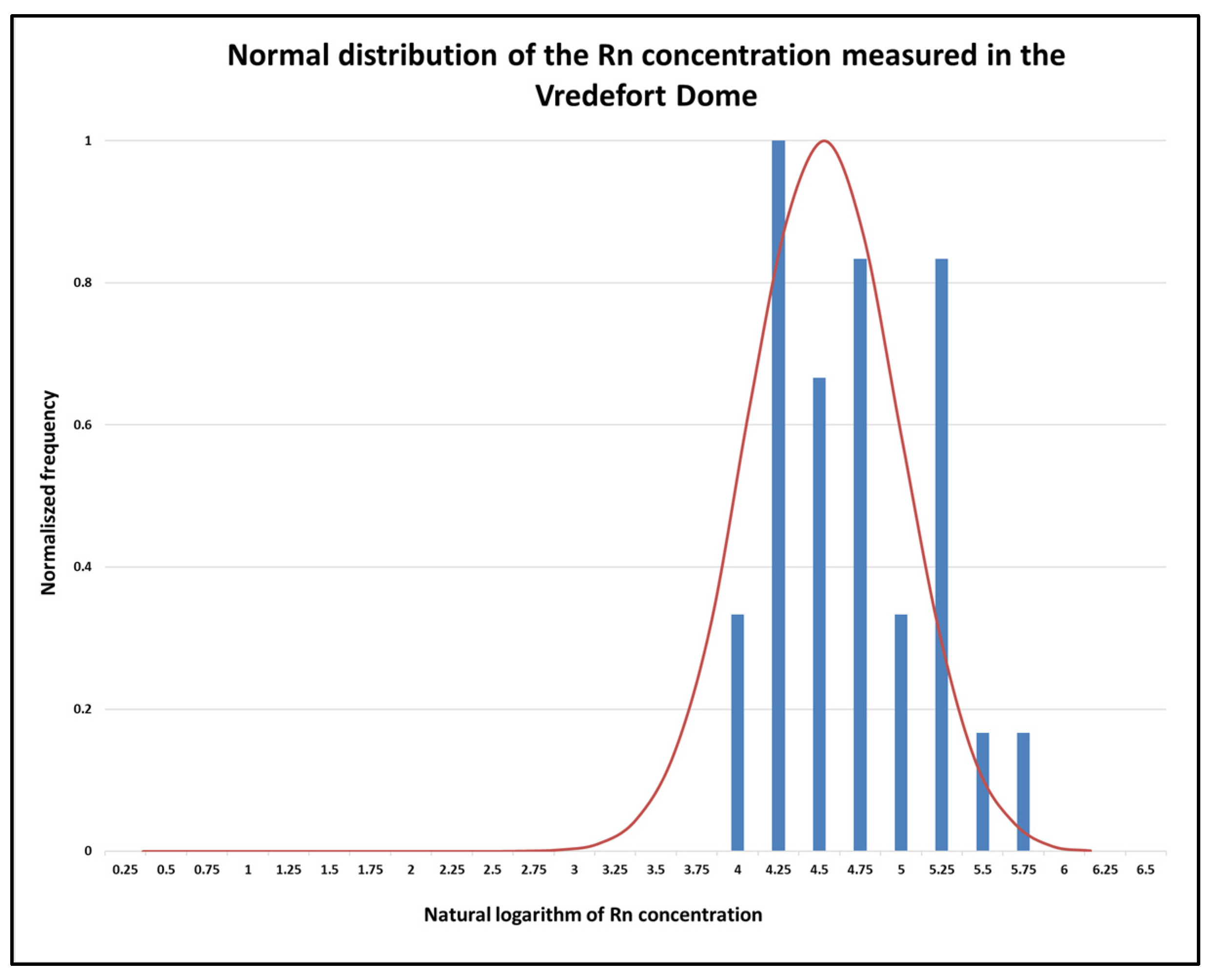
| Area | Sample | Calculated Rn Concentration (Bq/m3) | Average Rn Concentration (Bq/m3) |
|---|---|---|---|
| Farm 1 | 1 | 156.95 | 126.10 |
| 2 | 95.24 | ||
| Farm 2 | 1 | 64.24 | 104.14 |
| 2 | 61.98 | ||
| 3 | 57.92 | ||
| 4 | 185.46 | ||
| 5 | 99.32 | ||
| 6 | 155.89 | ||
| Farm 3 | 1 | 128.21 | 110.15 |
| 2 | 130.42 | ||
| 3 | 88.03 | ||
| 4 | 177.97 | ||
| 5 | 233.24 | ||
| 6 | 55.44 | ||
| 7 | 80.24 | ||
| 8 | 49.40 | ||
| 9 | 91.56 | ||
| 10 | 101.05 | ||
| 11 | 52.66 | ||
| 12 | 67.49 | ||
| 13 | 176.18 | ||
| Farm 4 | 1 | 280.45 | 124.95 |
| 2 | 112.31 | ||
| 3 | 87.35 | ||
| 4 | 87.04 | ||
| 5 | 57.60 | ||
| Mines | 1 | 299.18 | 364.22 |
| 3 | 248.46 | ||
| 4 | 710.86 | ||
| 5 | 198.38 |
Disclaimer/Publisher’s Note: The statements, opinions and data contained in all publications are solely those of the individual author(s) and contributor(s) and not of MDPI and/or the editor(s). MDPI and/or the editor(s) disclaim responsibility for any injury to people or property resulting from any ideas, methods, instructions or products referred to in the content. |
© 2023 by the authors. Licensee MDPI, Basel, Switzerland. This article is an open access article distributed under the terms and conditions of the Creative Commons Attribution (CC BY) license (https://creativecommons.org/licenses/by/4.0/).
Share and Cite
Le Roux, R.; Bezuidenhout, J. Assessment of Radon and Naturally Occurring Radionuclides in the Vredefort Meteorite Crater in South Africa. Atmosphere 2023, 14, 1826. https://doi.org/10.3390/atmos14121826
Le Roux R, Bezuidenhout J. Assessment of Radon and Naturally Occurring Radionuclides in the Vredefort Meteorite Crater in South Africa. Atmosphere. 2023; 14(12):1826. https://doi.org/10.3390/atmos14121826
Chicago/Turabian StyleLe Roux, Rikus, and Jacques Bezuidenhout. 2023. "Assessment of Radon and Naturally Occurring Radionuclides in the Vredefort Meteorite Crater in South Africa" Atmosphere 14, no. 12: 1826. https://doi.org/10.3390/atmos14121826
APA StyleLe Roux, R., & Bezuidenhout, J. (2023). Assessment of Radon and Naturally Occurring Radionuclides in the Vredefort Meteorite Crater in South Africa. Atmosphere, 14(12), 1826. https://doi.org/10.3390/atmos14121826






